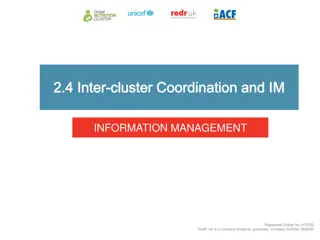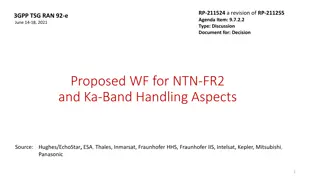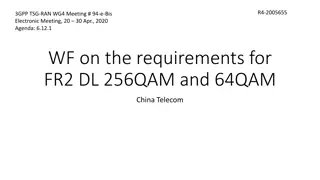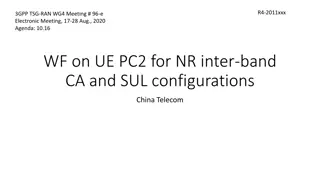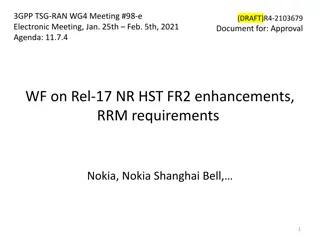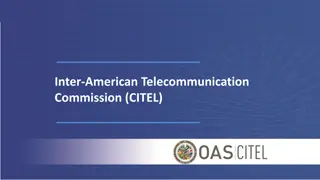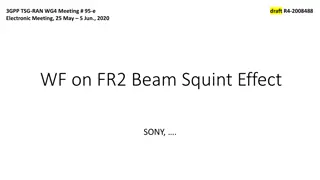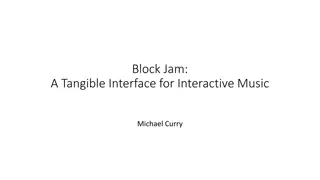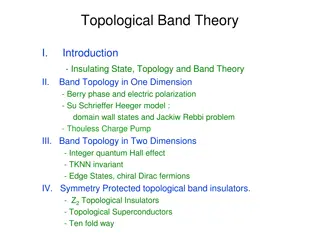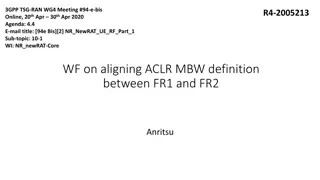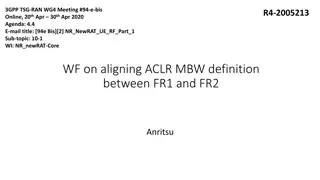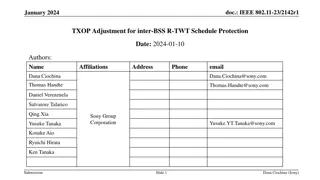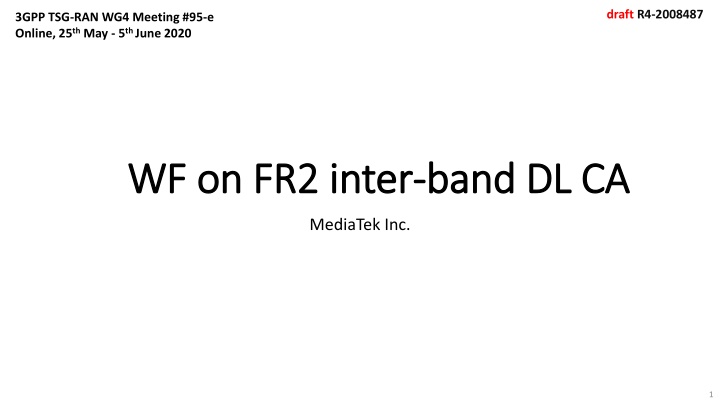
Band Pair Capability Signalling for Network Deployment Scenarios
Explore band pair capability signalling for co-located and non-co-located network deployment scenarios, focusing on beam management, resource allocation, and UE support, with insights on frequency separation and MRTD values.
Download Presentation

Please find below an Image/Link to download the presentation.
The content on the website is provided AS IS for your information and personal use only. It may not be sold, licensed, or shared on other websites without obtaining consent from the author. If you encounter any issues during the download, it is possible that the publisher has removed the file from their server.
You are allowed to download the files provided on this website for personal or commercial use, subject to the condition that they are used lawfully. All files are the property of their respective owners.
The content on the website is provided AS IS for your information and personal use only. It may not be sold, licensed, or shared on other websites without obtaining consent from the author.
E N D
Presentation Transcript
draft R4-2008487 3GPP TSG-RAN WG4 Meeting #95-e Online, 25th May - 5th June 2020 WF on WF on FR2 FR2 inter inter- -band DL CA band DL CA MediaTek Inc. 1
Background and wording alignment UE band pairs capability [1] CBM = common beam management between the band pair IBM = independent beam management between the band pairs Network assumes IBM UE supports both co-located and non-co-located deployments Network deployment scenarios [1] co-located deployment non-co-located deployment Illustration by L+H band pair example for reference Illustration by L+H band pair example for referenceonly only Network: Network: co-located deployment non-co-located deployment L H L H L H L+H L H IBM UE CBM UE IBM UE 2
Beam management (BM) resource Non-co-located deployment provides BM resource for both Pcell and Scell. Co-located and non-collocated deployment provides BM resource for Pcell, and may or may not provide BM resource for Scell. Network can decide Scell BM resource allocation based on UE s BM capability on the band pair. 3
Capability signalling Introduce UE IBM/CBM capability per band pair Whether further specific frequency separation class for CBM or not is FFS Introduce frequency separation class for band combinations with bands within one Band group, regardless of CBM or IBM Introduce MRTD value UE can support per band pair Considering Co-located deployment may have >0.26us MRTD, reporting MRTD UE can support can help gNB to decide on CA configuration Candidate values for MRTD signaling{0.26us,3us,8us} Introduce support of co-located and/or non-co-located deployment capability per band pair Alt-1: Yes It implies that UE IBM/CBM capability and whether support co-located and/or non-co-located deployment or not can be independent from signaling perspective Alt-2: No It implies: UE CBM band pair shall support co-located deployment and meet corresponding requirement UE IBM band pair shall support co-located and non-co-located deployment, and meet corresponding requirement 4
EIS requirements for co-located & non-co-located deployment About common coverage EIS requirement, that consider co-located deployment or 0.26 MRTD capability Alt-1 Inter-band DL CA common coverage EIS requirement shall be defined for IBM and CBM band pairs, respectively It implies while UEs meet inter-band DL CA common coverage requirement (#1), it means the UEs support co- located network deployment. Alt-2 Inter-band DL CA common coverage EIS requirement shall be defined for IBM bands pairs only It implies while IBM UEs meet inter-band DL CA common coverage requirement (#1), it means the IBM UEs support co-located network deployment. It implies while CBM UEs meet spherical coverage requirements of each band in single carrier mode, it means the CBM UEs support co-located network deployment About non-common coverage EIS requirement, that consider non-co-located deployment or {3us,8us} MRTD capability No matter UE capability is IBM or CBM, no need to define non-common spherical coverage requirement (#2) For IBM UE, while it meets common coverage EIS requirement, it implies the IBM UE also can support non-co- located deployment. For CBM UE, network does not assume CBM UE supports non-co-located deployment [1]. Hence, no 5
EIS requirements for co-located & non-co-located deployment (cont d) Overview table for reference only Network scenario: Network scenario: Co-located deployment or 0.26 MRTD capability (#1) Inter-band DL CA common coverage EIS requirement: Non-co-located deployment or {3us,8us} MRTD capability (#2) Inter-band DL CA non-common coverage EIS requirement: UE IBM band pair Shall be defined (#1) Inter-band DL CA common coverage EIS requirement No need to define (#2) Inter-band DL CA non-common coverage EIS requirement: UE CBM band pair Alt-1: shall be defined Alt-2: no need to define No need to define (*) (*) Network does not assume CBM UE supports non-co-located deployment [1] 6
BackGround:(#1) Inter-band DL CA common common coverage EIS requirement Adopt requirement on common area of where both bands meet their respective single CC EIS spherical coverage requirements (separate inter-band CA relaxations may apply) Equivalent requirement values are FFS Illustrations for reference Illustrations for referenceonly only The area of sphere pass CC1+CC2 inter-band DL CA common coverage EIS requirement The area of sphere pass CC2 requirement The area of sphere pass CC1 requirement 7
Equivalent inter-band DL CA EIS requirement framework Equivalent inter-band DL CA EIS requirement framework: Inter-band DL CA peak EIS = Single-band EIS_peak + MBR_peak + inter-band DL CA relaxation_peak Inter-band DL CA spherical EIS = Single-band EIS_spherical + MBR_spherical + inter-band DL CA relaxation_spherical The inter-band DL CA relaxation value would consider such as extra hardware component loss/beam squint loss/common coverage loss in discussion stage 8
Inter-band DL CA relaxation value portfolio About different band pairs, relaxation value is defined: Alt-1: per band pair Ex: n257+n260 and n258+n260 may have different relaxation value Alt-2: per band pair type among existed bands (i.e. intra-group and inter-group concept) Ex: all L(28)+H(39) band pairs apply same relaxation value. Ex: n257(L)+n260(H) and n258(L)+n260(H) have same relaxation Alt-3: as one relaxation value for all band pairs among existed bands About UE IBM/CBM capability, relaxation value is defined: Alt-1: as one relaxation value for both IBM/CBM capability Alt-2: as respective relaxation values for IBM/CBM capability, respectively If inter-band DL CA relaxation value of specific band pair is not defined yet, it means that there is no corresponding inter-band DL CA requirement. 9
Inter-band DL CA relaxation value evaluation Companies are encouraged to provide inter-band DL CA band pair requests from market demand Companies are encouraged to show what loss components are included of the proposed inter-band DL CA relaxation value If the specific loss component is not applicable for specific proposal from technical judgement, to show 0 dB is suggested rather than remove the whole loss component. Example for reference only For L+H band pair type inter-band DL CA relaxation value Loss components (dB) Extra hardware component loss Beam squint loss Common coverage loss Other loss Proposal Relexation_peak Relexation_Spherical 10
PSD difference PSD for CBM band pair Minimize PSD difference in test condition PSD for IBM band pair is FFS 11
References Tdoc # Title Source [1] R4-2005736 WF on inter-band DL CA_v3 GTW Qualcomm 12





